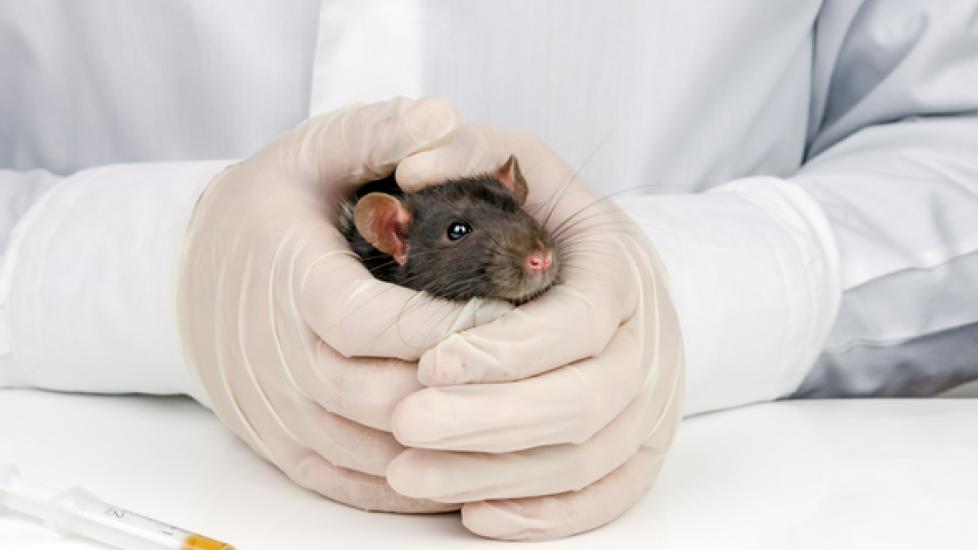Cancer Treatment for Small Animals
by Vanessa Voltolina
In 2016, it’s expected that more than 1.6 million new cases of cancer will be diagnosed in the United States. Sadly, the impact of cancer isn’t solely a human problem. While many of us are aware of the cancers—and treatments—that cats and dogs undergo, cancers and treatment options in small animals (rabbits, ferrets, rodents, etc.) aren’t discussed as often.
Not all cancers are created equal, so it’s vital to know the options that are available for your rabbit, ferret, guinea pig, or hedgehog. Here, experts weigh in on your questions about which types of cancer are most common in small animals, as well as treatment options for them.
What Kinds of Cancer Affect Small Animals?
Cancer in Rabbits
“Un-spayed (intact) female rabbits are particularly prone to development of reproductive tumors; namely, uterine adenocarcinoma, the most common,” said Jennifer Graham, DVM, DABVP, DACZM, and assistant professor at the Cummings School of Veterinary Medicine at Tufts University. Uterine adenocarcinoma is so common, in fact, that intact females over three years of age have around an eighty percent chance of developing one, she said.
Some signs to look out for include bleeding from your rabbit’s vulva and changes in appetite or activity level. However, many rabbits show no or minimal signs until it’s too late, said Graham. That’s why she advises pet parents to spay all female rabbits before one year of age, as it can prevent the development of reproductive tumors.
Another type of cancer in rabbits is lymphoma (a blood cell cancer), with signs varying depending on the cancer’s type and location. “Owners should watch for any signs of visible masses, or changes in appetite or activity level,” Graham said.
Rabbits can develop many other types of cancer, including thymomas, said small animal oncology expert Joanne Intile, DVM, DACVIM of East End Veterinary Center in Riverhead, NY. Thymomas occur when a tumor originates from the thymus gland in the chest, Intile explained. “As the tumor becomes larger, rabbits may show increased respiratory effort and can also have the appearance of bulging eyes,” she added. Additional symptoms include third eyelid protrusion and facial swelling, said Intile.
Cancer in Ferrets
According to Graham, ferrets are most prone to development of insulinoma, adrenal tumors, and lymphoma. A common symptom of insulinoma in ferrets includes low blood sugar (glucose), which may lead to signs of weakness, lethargy, and sometimes even seizures.
Adrenal gland tumors involve a cancerous change in the adrenal glands, resulting in increased sex hormone production, said Graham. According to Intile, signs to look for include itchiness and occasionally vulvar swelling in females and urinary tract blockage in males. Hair loss is the most common sign of an adrenal tumor, said Intile.
The most common laboratory finding in ferrets with lymphoma is anemia. Affected ferrets may have a decreased activity level and weight loss, said Graham. “Lymphoma can be associated with enlarged lymph nodes, but not in every case,” she added.
Cancer in Rats
The most common tumor in rats is mammary gland tumor, with an incidence of fifty to ninety percent in unspayed female rats and sixteen percent in male rats, said Graham. Most rat tumors are benign, added Graham, but can grow quickly and occur anywhere on the shoulder, neck, belly, flank, or tail base.
Another type of cancer seen in rats is pituitary gland tumor, which can be associated with rapid weight loss and neurologic signs, according to Graham.
“Pituitary tumors occur in older rats of either sex,” said Marcie Logsdon, DVM, of the Exotics and Wildlife Department at Washington State University Veterinary Teaching Hospital. Signs of pituitary tumors can include increased drinking and urination, weight loss, weakness in the hind legs, and occasionally a bulging eye, she said.
“There is a new treatment protocol using a drug called cabergoline that may have some efficacy in decreasing tumor size,” Logsdon said. She noted, however, that this treatment is relatively new and remission times have not yet been established.
Cancer in Guinea Pigs and Hamsters
Similar to intact female rabbits, unspayed female guinea pigs are also prone to developing uterine tumors. Signs include abdominal distention and, on occasion, vaginal bleeding, said Graham. Other common tumors include mammary tumors, basal cell tumors, trichofolliculoma (a benign skin mass), and lipoma (fatty tumor). These tumors can occur in both male and female guinea pigs, she added.
In hamsters, the most common tumor type to be aware of are adrenal tumors. “These usually occur in hamsters from two to three years of age and can be associated with hair loss, changes in behavior, and discolored skin,” said Graham. Melanoma, a type of skin cancer, can also occur in hamsters and is more common in males than females.
Cancer in Hedgehogs
Unfortunately for hedgehog owners, this small animal is prone to developing tumors. “Squamous cell carcinoma is a common tumor found in the mouth of hedgehogs, and can be associated with difficulty eating, swelling inside or around the mouth, drooling, and weight loss,” said Graham. And like their rabbit and rat counterparts, female hedgehogs can be prone to reproductive tumors such as uterine and mammary tumors.
Recommended Products
Are Some Cancers in Small Animals More Treatable than Others?
The good news is that just as some cancers are more treatable than others for cats and dogs, the same is true for small animals, said Intile. In particular, “skin cancers are usually highly treatable with surgery,” she said. Additionally, insulinoma and adrenal gland disease can be surgically or medically managed in ferrets, per Graham.
Lymphoma in ferrets is also a treatable disease. However, Graham notes that, it’s usually not associated with as long a survival period as are treatments for insulinoma or adrenal gland disease.
More good news: reproductive tumors have a good chance of being treated as long as they are detected early (before metastasizing). It’s also been found that there’s a significant decrease in the incidence of mammary tumors in female rats who are spayed early in life.
Sadly, some tumors—such as oral tumors in hedgehogs—do not have a good prognosis in most cases. “They are aggressive and can spread to the bone (jaw) before detection,” said Graham.
Remember that in cases when cancers have spread (metastasized), or situations in which your pet is very sick or is in pain or discomfort, even cancers that are considered “treatable” may not warrant aggressive therapy, explains Intile.
Is There a Typical Treatment for Small Animal Cancer?
Treatment type will depend upon the type and severity of the cancer. The first step is to bring your pet to your trusted exotics veterinarian. Your vet would then “perform an exam and recommend appropriate diagnostics, depending on the type of cancer,” said Intile. This may include bloodwork, radiographs, ultrasound exams, biopsies, or cytology samples. “Once a definitive diagnosis of the cancer type is made, a treatment plan would be identified,” she said. That plan may include surgery, radiation therapy, chemotherapy, or a combination of therapies.
Whatever the treatment plan, it’s all about moving forward with what makes the most sense for you and your pet. For example, while thymomas in rabbits can be surgically removed, this is a high-risk procedure, said Graham. “We have had very good success with managing these rabbits with radiation therapy, and this is generally our treatment recommendation.”
In the case of reproductive tumors in rabbits, Graham said diagnostics including CT or MRI are recommended to determine the extent of a tumor and make the best treatment plan. These reproductive tumors are very treatable as long as they are detected early (before metastasizing), she said. Graham also notes that she has had success with a “no-IV” chemotherapy protocol (drugs are given orally and by injection under the skin) to manage some ferrets with lymphoma.
"Some tumors can be managed with intralesional chemotherapy, which involves injecting the tumor with drugs and allows us to minimize side effects when compared to systemic/whole-body therapy," said Graham.
For rats, surgery can remove mammary tumors. However, adjunct therapy—including spaying or hormone blockers—may be recommended to help reduce the incidence of tumor recurrence, she said.
How Much Should I Expect to Pay for Treatment?
The short answer: It varies. “The cost of therapy depends on the type of tumor we are managing,” said Graham.
Experts agree that therapy can be as little as $20 for monthly medications like steroids, to a few hundred dollars for uncomplicated surgical cases, to thousands of dollars. “Chemotherapy fees depend on the type of cancer treated,” adds Graham. “Some treatment plans cost around $1,000 if we are providing multiple weeks of therapy with follow-up blood work in the treatment plan.” A palliative course of radiation can hold a price tag of around $2,500, she added.
“Keep in mind that any type of cancer can happen in any animal, and those mentioned above are just some of the more common types of cancers encountered in exotic pets,” said Logsdon.
“Adjunct therapies such as radiation therapy, chemotherapy, or even electrochemotherapy, have been used with success in many exotic animal species, Logsdon said. If surgical removal is going to be considered, she added, remember that it is safer, less expensive, and more likely to be successful the earlier it can be pursued—ideally when the tumor is still small—rather than later.
Read more
The Cost of Cancer Treatments for Pets
For Pets, 'Quality of Life' Supersedes 'Life at All Costs'




